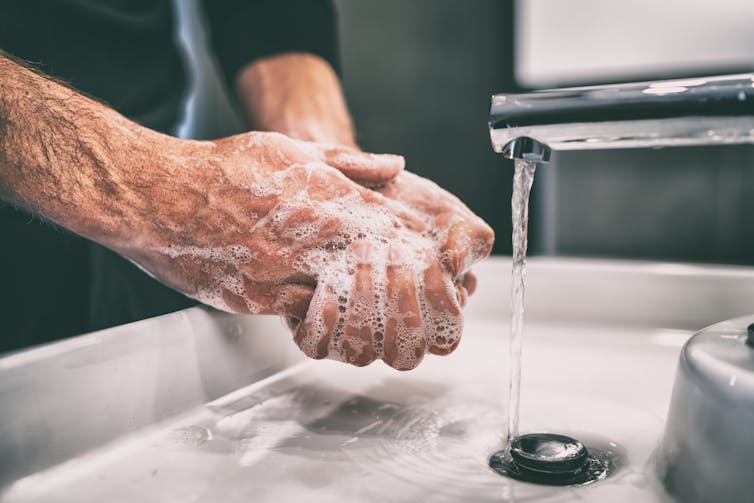What's the difference between viral shedding and reinfection with COVID-19?
- Written by Lara Herrero, Research Leader in Virology and Infectious Disease, Griffith University
Over recent weeks and months, we’ve heard of several COVID cases in which people have tested positive after previously clearing the virus.
Scientists are hopeful being infected with COVID-19 confers immunity for a length of time. But some of these instances have raised concerns about reinfection. Although rare, it seems to be possible.
The other thing which could be at play in many of these cases is “prolonged viral shedding”.
Both phenomena are probably more common than we realise. But it’s important to understand the differences between the two.
What is viral shedding?
When you’re sick with a virus, the cells in your body hosting the infection release infectious virus particles, which you then shed into the environment. This process is called viral shedding.
For SARS-CoV-2, the virus that causes COVID-19, shedding primarily occurs when we talk, cough, sneeze, or even exhale. SARS-CoV-2 can be shed in a person’s stool, too.
Research shows shedding of infectious SARS-CoV-2 begins before a person starts displaying symptoms, and peaks at or just after symptom onset (usually four to six days after infection).
Shedding can continue for several weeks after a person’s symptoms have resolved — there’s no standard time frame.
Research has identified shedding of infectious SARS-CoV-2 virus particles from up to eight days after symptom onset in hospitalised patients, to up to 70 days after diagnosis in an immunocompromised person.
 People begin shedding SARS-CoV-2 before they develop symptoms.
Shutterstock
People begin shedding SARS-CoV-2 before they develop symptoms.
Shutterstock
Not all shedding is equal
In the above cases, the viral particles being shed are infectious, which is what we as virologists consider viral shedding to mean. But during COVID-19, the definition of shedding has been broadened to include the shedding of viral genetic material (RNA).
Although RNA constitutes fragments of the virus, these aren’t necessarily infectious fragments.
Studies measuring the shedding of viral genetic material from the respiratory tract have reported shedding typically lasts around 17 days.
Shedding of SARS-CoV-2 genetic material can persist for more than 80 days in the upper respiratory tract, and over 120 days in the stool.
Where people have recovered and then later test positive again — or return a “weak positive” result — the test has picked up viral genetic material. We don’t know whether the virus is infectious at this point.
So, how can you tell?
Currently there’s no simple way to determine whether a person is shedding infectious virus, or how much.
The “gold standard” method used to diagnose COVID-19 is the PCR test. PCR tests detect viral genetic material (RNA in the case of SARS-CoV-2) from a patient’s swabbed samples.
But they can’t determine whether the virus is alive or dead, or, in other words, if the virus is infectious.
The level of infectious SARS-CoV-2 can only be determined using infectivity methods (called assays). These are common in research laboratories, but are not used as diagnostic tests.
Read more: How long are you infectious when you have coronavirus?
Why do some people shed for longer?
There’s no evidence to suggest people who shed SARS-CoV-2 genetic material for a long time in their faeces have been sicker with COVID-19. Though some research has found prolonged shedding in the respiratory tract can be linked to more severe disease.
We don’t fully understand the factors that make a person a “long shedder”, but research into this is ongoing. Certain groups have been associated with prolonged SARS-CoV-2 shedding, including males, children, older adults, and people with compromised immune systems.
There’s also speculation factors such as the amount of SARS-CoV-2 which caused the infection (the viral dose), and possibly the viral strain, may play a role.
In the absence of targeted antiviral drugs, shedding can’t be stopped. But, by sticking to COVID-safe guidelines such as keeping an adequate distance from others, wearing a face mask, and practising hand hygiene, we can minimise the risks from a person unknowingly shedding infectious virus.
 Following COVID-safe measures can protect against viral shedding.
Shutterstock
Following COVID-safe measures can protect against viral shedding.
Shutterstock
Long viral shedding versus reinfection
Reports of reinfection — in the sense of a new infection, rather than prolonged or intermittent shedding of the same one — have been limited to date. One source collating confirmed reinfection cases indicates there have been just 26 worldwide.
Evidence we have from other coronaviruses suggests the risk of reinfection may be lower in the first 90 days after initial infection.
Some studies on COVID-19, both published and not yet formally published in a peer-reviewed journal, suggest immunity may last for several months. But we need more evidence on this topic, which we will accumulate as time passes.
Where a person does test positive several weeks or months after they’ve recovered, the difficulty is confirming reinfection. That’s because this requires genetic testing of both infections to determine whether they are in fact different.
Given this is time consuming and the technology isn’t widely accessible, it’s highly likely there are more than 26 cases of reinfection around the world.
Read more: New research suggests immunity to COVID is better than we first thought
Shedding, reinfection and community spread
While the virus appears to be under good control in Australia, prolonged viral shedding and reinfection are probably two of the most important drivers of SARS-CoV-2 community transmission around the world.
Understanding how and for how long people can shed SARS-CoV-2, and which factors increase the risk of viral shedding or reinfection, can help us to improve surveillance and reduce the rate at which the virus spreads.
Authors: Lara Herrero, Research Leader in Virology and Infectious Disease, Griffith University


















